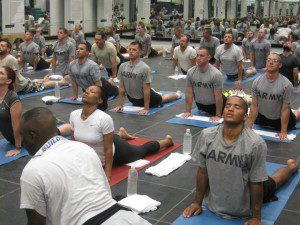Yoga has many benefits to the body, mind and spirit and can help one to heal from many types of traumas. Our nation’s military personnel who have served in combat zones are one of the most traumatized segments of our population and as such it is wise to find new ways of helping them to return to normal lives. Yoga has the power to help.
Below are excerpts from a military study on the effects of Hatha Yoga on soldiers stationed in Iraq. As one may guess, the soldiers who received instruction in Yoga showed significant improvement in their emotional and physiological well-being, leading to the conclusion that Yoga is indeed a useful tool in dealing with combat and environmental stress.
[pro_ad_display_adzone id=”110028″]
The American Journal of Occupational Therapy
ABSTRACT:
OBJECTIVE. We examined the effects of sensory-enhanced hatha yoga on symptoms of combat stress in deployed military personnel, compared their anxiety and sensory processing with that of stateside civilians, and identified any correlations between the State–Trait Anxiety Inventory scales and the Adolescent/Adult Sensory Profile quadrants.
METHOD. Seventy military personnel who were deployed to Iraq participated in a randomized controlled trial. Thirty-five received 3 wk (9 sessions) of sensory-enhanced hatha yoga, and 35 did not receive any form of yoga.
RESULTS. Sensory-enhanced hatha yoga was effective in reducing state and trait anxiety, despite normal pretest scores. Treatment participants showed significantly greater improvement than control participants on 16 of 18 mental health and quality-of-life factors. We found positive correlations between all test measures except sensory seeking. Sensory seeking was negatively correlated with all measures except low registration, which was insignificant.
CONCLUSION. The results support using sensory-enhanced hatha yoga for proactive combat stress management.
INTRODUCTION:
According to a 2008 RAND Center for Military Health Policy Research study, nearly 20% of combat troops returning from Iraq or Afghanistan met criteria for either posttraumatic stress disorder (PTSD) or depression. Of the estimated 300,000 returning troops, only 53% sought help from a provider in the year of the study. Fear of adverse consequences and stigma were frequently cited reasons for not seeking help (RAND Center for Military Health Policy Research, 2008).
Consequences of not obtaining treatment may include substance abuse, domestic violence, divorce, job loss, financial difficulties, homelessness, and suicide and can be devastating to the individual military member, the family unit, and society (National Center for PTSD, 2006). To avert these outcomes, the RAND Center for Military Health Policy Research (2008) report recommended finding ways to allow deployed military members to receive mental health care off the record.
Unfortunately, traditional mental health care may be insufficient to address these problems, because studies have shown that talk therapies alone have limited success in treating PTSD (Ogden, Minton, & Pain, 2006; van der Kolk, 2006) and can even increase dysregulation (Ford, Courtois, Steele, van der Hart, & Nijenhuis, 2005; Ogden et al., 2006). Imaging studies have shown that Broca’s area, a major language center of the brain, can become deactivated in response to traumatic reminders, a finding that may explain why PTSD sufferers are often at a loss for words to discuss their trauma (Shin et al., 1999).
Many experts now believe that people with PTSD need physical experiences to counter the chronic sense of emotional and physical helplessness that frequently results from trauma (Levine, 1997; Ogden et al., 2006; van der Kolk, 2004). According to Levine (1997), the residue of undischarged energy from the freeze response during a traumatic event may lead to the debilitating symptoms of PTSD, which fall into three clusters: (1) reexperience of the phenomenon (e.g., flashbacks), (2) avoidance and numbing, and (3) autonomic hyperarousal (American Psychiatric Association, 2000). Newport and Nemeroff (2003) believed that disturbances in sensory processing play an important role in the hyperarousal symptoms of PTSD, hypothesized by Rothschild (1998) to be at the core of the disorder.
According to van der Kolk (2006), people with PTSD need to learn that internal feelings and sensations are safe and continuously change, unlike the freeze state, when everything seems to stand still. He further asserted that by achieving control over their physiological states through breathing and movement, these people may avoid overwhelming emotions when recalling their traumas.
Yoga, which incorporates both breath work and movement, is becoming increasingly recognized as an effective treatment modality for reducing symptoms of PTSD (Miller, 2009; Pollack, 2010; van der Kolk, 2006; Wills, 2007). Van der Kolk (2006) found that hatha yoga significantly increased heart rate variability (an indicator of increased parasympathetic tone) in typical participants. In the same study, the PTSD group showed a significant reduction in PTSD symptoms as measured by the Clinician-Administered PTSD Scale, a clinical PTSD assessment tool (Blake et al., 1995; van der Kolk, 2006).
[pro_ad_display_adzone id=”110317″]
DISCUSSION
Sensory-enhanced hatha yoga was shown to be effective in reducing both state and trait anxiety in deployed military personnel, despite normal pretest scores. One possible explanation may be that the intervention triggered an inhibitory effect on the autonomic nervous system, which in turn may have contributed to improvements in health and quality-of-life indicators. Pairing positive affirmations with the neurophysiological effects of the asanas may have helped participants reframe negative thinking patterns that may have developed in response to stressors inherent in a deployed location. The readings may have helped orient participants to the present moment rather than replay past or anticipate future events. The systematic study of each of these elements may be needed to fully determine their contributions to the results. However, the combination of these bottom-up and top-down methods may ultimately be the critical feature of the sensory-enhanced hatha yoga.
Finally, the positive effect of the yoga treatment on quality of life suggests implications that may be immediately applied in military environments. Specifically, using sensory-enhanced hatha yoga in deployed environments for those with sleep difficulties may provide the most practical, nonpharmaceutical alternative for military personnel.
The healing power of Yoga is immense. Perhaps someday even the leaders of our society will be required to practice Yoga as a means of giving them the temperament for justice and peace that most Yogis already enjoy.
About the Author
Dylan Charles is the editor of WakingTimes.com. Originally from Austin, Texas, the infowar capital of the world, Dylan is currently living in tropical Latin America with his beautiful wife and three happy children. Both a teacher and student of Kung Fu, Tai Chi, Chi Kung, and Yoga, Dylan is a passionate believer in the power of personal transformation and its ability to positively impact the world. Part activist, part spiritual voyager, part recluse, Dylan envisions his work with Waking Times as an opportunity to assist others in liberating themselves from the confines of fear and violence based programming. His shamanic adventures have instilled in him an intense appreciation of the Earth and a dramatic ability to empathize with the suffering of those trampled under by institutional greed and corrupt politics. Dylan wishes to spread hope and confidence to those who are helping to pioneer a new future for mankind through the exploration of consciousness, permaculture, science and spirituality. Dylan is also proprietor of Pura Vida Yoga Vacations.
[pro_ad_display_adzone id=”110027″]







